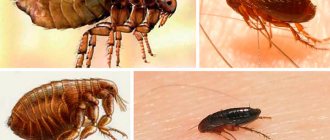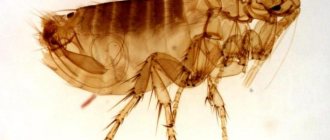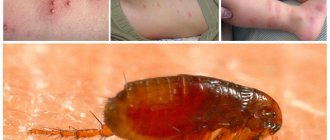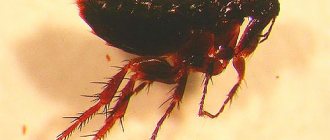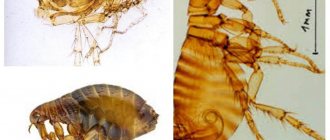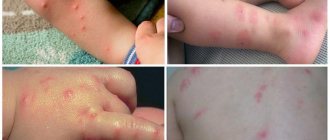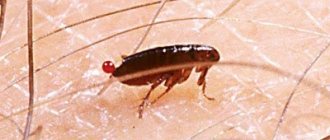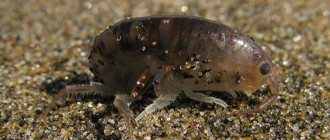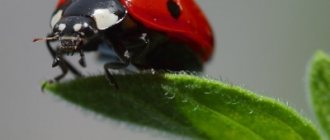Most often, pet owners encounter fleas. As a rule, they do not attach much importance to all the dangers that these insects cause to pets and people. Some people believe that dog or cat fleas do not attack people, but this is not true. In this article we will talk in detail about the existing types of fleas, their lifestyle and habitat, as well as the harm they can cause to people and animals. Here are tips on how to get rid of fleas in the house on your own using insecticides or traditional methods. Schoolchildren will be able to find many interesting points for writing an essay about fleas.
Description of fleas: lifestyle, body structure
Fleas belong to the order of blood-sucking arthropods. The length of the parasite can reach 5 mm, females after feeding grow up to 1 cm, fertilized ones - up to 1.5 cm. The body of the flea consists of a head and abdomen covered with chitinous cover, the body is flattened on the sides. Thanks to this shape, the insect easily moves among feathers, fur and clothing. Color ranges from yellow to almost black.
Interesting! During the process of evolution, many animals have changed in appearance. Scientists have found that the modern flea looks almost the same as its ancestors.
Fleas do not have wings, and they move by jumping with the help of three pairs of long and strong limbs. Some species have shorter paws, so they are constantly on the host's body. The paw consists of five segments and ends with sharp bristles-claws, forked at the end.
The flea's body is covered with spines and bristles, which helps it move very quickly throughout the victim's body. The head has serrated ridges. Due to this structure, the parasite cannot be combed out, chewed out or removed; it can only be crushed with a fingernail.
At the back of the abdomen is the pygidium, a sensory organ covered with tactile hairs. They react to small changes in air and warn of danger.
The reproductive system of the female consists of the oviduct, ovaries and spermatic receptacle (in the shape of a curved flask), and of the males - the genital claw (copulatory organ).
There are antennas behind the eyes. With them, males hold onto females during mating. The rest of the time they are in the antennal fossae.
The type of oral cavity is piercing-sucking. After biting the skin, the flea enlarges the wound, secretes saliva, which prevents blood clotting, then penetrates deeper and moves to the blood vessel, where it sucks blood. A flea cannot crawl completely under the skin.
External structure
The order Fleas (Fig. 99B) are wingless, small insects, 1-5 mm in size, flattened as if they were being diligently pressed from the sides. The head and chest are small, like appendages of powerful hind legs and a huge abdomen. The smooth and slippery body is lined with elastic, backward-directed bristles and hairs.
This body shape is very convenient for movement in the thick fur of mammals and the feathers of birds, where fleas live. In addition, they are excellent jumpers, able to make jumps many times greater than their body size. Thanks to this, they can quickly and deftly get onto the body of their owners, and at the same time avoid defensive actions on their part.
Lifestyle and behavioral characteristics
Fleas can always be seen, regardless of the time of year, on the owner or in his home. The main carriers are mammals that have a nest, burrow or live in an apartment. Some types of fleas settle in nests left for a long time. Homeless animals do not have their own home, so their fleas live on their bodies all year round and breed there. Parasites suck blood, regardless of gender, from one minute to several hours. When food runs out, insects can live for a long time (months) without food, but then they attack the owner with greed.
Interesting! A flea's jump is about 100 times longer than its body length.
Methods of control and prevention
People living in apartments on lower floors, keeping pets, having summer houses and garden plots, as well as storing things in basements, must first of all prevent the appearance of fleas.
During the winter heating season, a favorable environment is created in the basements of houses for the development and vital activity of synanthropic flea species. This is the optimal temperature and humidity required for ectoparasites.
In this regard, it is necessary:
- First of all, limit or completely eliminate the access of cats and dogs to basements by sealing holes and windows.
- When keeping pets, use hygiene products (shampoos, soaps) based on insecticides, flea collars, etc.
- After deratization (destruction of rodents), immediately carry out disinfestation (extermination of insects).
- All flea-infested premises in one building are treated simultaneously (on the same day) or for 2-4 days in a row.
Do you have fleas? Contact us! Our specialists will not only correctly identify the type of fleas and develop a strategy for a set of measures, but will also carry out effective disinfestation of your premises with suitable preparations.
Types of fleas
There are about 22 families of fleas, which include various species.
- The human flea is the most common species. A brown insect up to 3.2 mm long, jump height 30 cm, length 50 cm. It has no thoracic or head teeth. Sucks the blood of humans and animals. Carries plague pathogens and causes pulicosis. The blood is sucked for up to 20 minutes and digested for 6 hours.
- The cat flea infests all animals, even humans. Carries many infections. The larvae develop in animal fur and bedding. Body length is up to 5 mm, females are larger - up to 1.6 cm. They live up to two years.
- The dog flea lives on dogs, cats and humans. Carries flatworms and other parasites, is the keeper of the pathogens of plague, leprosy, and Marseilles fever. Size up to 5 mm, lives up to 1.5 years.
- The rat flea is recognized as the most dangerous species, carrying plague, mouse and rat tapeworm. The length of females is 2.7 mm, males - 2 mm. Color ranges from light brown to darker. Females lay eggs in rat nests.
- The Tien Shan flea, as the name suggests, lives in the Tien Shan. The fertilized female increases in length, which gives them a worm-like appearance. The length of males is 4 mm, females – 5 mm, color black. Fleas appear in winter, rising from the frozen ground onto the body of livestock. The insects soon become larger, changing color to white.
- The grass flea (up to 3 mm long) lives on trees, bushes, grass, and gets into the apartment with the help of pets. It differs from other species in the presence of wings.
- The penetrating flea (sand flea, Brazilian ground flea) is native to Haiti, Brazil. Length 1 mm, jump height up to 35 mm. The fertilized female becomes round with a diameter of up to 1 cm. Lives in dry grass, jumps on humans, birds and animals. Males drink blood, and females get under the skin of animals' legs or human nails, causing inflammation and tetanus, which leads to gangrene, amputation, and in some cases death.
There is a species called the bed flea, which lives on upholstered furniture and bed linen (another name for linen flea). They bite a person at night in the areas of the body with the thinnest skin.
Human jumpers
Among the variety of blood-sucking species, there are also human parasites. The most preferred source of food is humans themselves. In appearance, pests are not very different from their relatives. Like other jumping parasites, they do not constantly parasitize the human body.
Most often, pests can be found on parts of the body covered with hair. You can feel a flea bite, but crushing it is not so easy. The insect is slightly vulnerable, so it immediately moves to another place and bites the victim again. The danger of parasites lies in the transmission of the following diseases:
- plague;
- encephalitis;
- anthrax;
- helminthiasis
- rashes at the site of the bite;
- the appearance of ulcers in the mouth and throat;
- increased body temperature;
- enlarged lymph nodes;
- migraine;
- sleep disorders.
The consequences of bites differ in symptoms:
All varieties of human or bed fleas attack mainly humans, feeding on their blood. However, in the absence of people, pests can just as easily attack domestic animals. A bed flea jumps onto its victim, pierces the skin, and then feeds on blood from a blood vessel. After saturation, it leaves the host's body. When talking about whether a person has fleas, the question is posed incorrectly.
Parasites live in the house, in close proximity to the food source, but do not live permanently on the body of a person or animal, unlike lice.
Where to buy an effective remedy
| Pharmacy name | Address | Name of the drug | Price, rub |
| Online store "Seeds here" | Moscow, Strelbischensky lane, building 5. | Phenaxin Pyrethrum | 42 |
| Online store Zakupka.com | St. Petersburg, Udelny pr. 17 | Finaxin | 77 |
| Online store "Farm Plus" | Minsk, Minsk, Z.Byaduli st., no.11 | Clean house | 23 |
| Online store Prom.ua | Kiev, Kharkov highway, 201/203, building 2-A | Finaxin | 15 UAH |
What species are transmitted from animals
As a rule, fleas prefer to feed on animal blood rather than human blood, so the risk of infection from the bites of these parasites is significantly reduced. But if a flea carries a dangerous disease, a person can become infected from a pet, the most dangerous of which are plague and rabies.
All types of insects in an apartment parasitize a specific animal or bird. Among the most common types of pests that can be transmitted to humans are:
- feline - feeds on the blood of cats, but if a person is nearby, it can bite him too. All types of cat parasites are very dangerous for people, as they carry brucellosis, plague, encephalitis, salmonellosis, hepatitis, and can also cause epidemics. Pest bites are very painful, cause skin irritation, rashes, itching, and when scratched, pustular inflammations form;
- rat - a type of insect that settles indoors in the presence of a large amount of garbage and dirt. Parasites can successfully develop behind baseboards, under old carpets and in other secluded places. Adults can easily attack humans. Rat pest bites are quite painful. The bite site is very itchy, swelling appears, and an allergic reaction may develop with fever and enlarged lymph nodes;
- dog - enter the apartment along with the animal. If the owner comes into direct contact with the pet, it can jump onto a person and bite. Parasites can starve for several months. In addition to dogs and people, they attack cats. The appearance of the parasite can be seen below.
This is not the entire list of parasites transmitted from animals. According to research results, each species of mammals and birds has its own blood-sucking parasite, so it is quite problematic to answer how many types of insects there are.
Universal methods of struggle
Today, all types of flea parasites in humans can be removed using powerful insecticidal solutions that are as safe as possible for health. Some insecticides can destroy the population of parasites and their larvae in a few hours.
Pests can be poisoned with two types of substances:
- Aerosols - the smell penetrates insects with the air. These remedies act quickly, so they allow you to get rid of parasites in one day.
- Powders or suspensions - get inside through the outer integument of parasites. The products last longer in the apartment than aerosols, so they work more reliably against insects.
Let's look at ways to use different pest control products:
1. Aerosols - this product must be sprayed over the maximum area, and the treatment scheme implies:
- carrying out wet cleaning of the premises in order to remove debris where larvae or eggs of parasites may be hiding;
- it is necessary to move all the furniture away from the walls, remove carpets from the walls;
- all residents of the apartment, including animals, must leave the premises for several hours, or even better, for the whole day;
- sprayed an aerosol product under carpets, on upholstered furniture, near baseboards, cracks in doorways;
- wait several hours, closing all doors and windows;
- then ventilate the apartment, vacuum or beat the carpets, and wet clean the room.
2. Powder products - must be scattered in the expected habitats of parasites, as well as in places where dust accumulates the most. This remedy is effective only if it gets on the body of the pest, so adult fleas die very quickly.
Among the most popular are:
- Phenaxin pyrethrum - made from chamomile extract. Despite its simple composition, the product works very effectively;
- Finaxin - in addition to fleas, is effective against flies;
- Clean House is a dust that is effective against many types of insects, such as bedbugs, cockroaches and ants.
3. Thermal treatment of the room - involves freezing and burning:
- freezing - as soon as the air temperature outside drops below 20 degrees, you need to open all windows and doors to cool the room. The method is effective, but the disadvantage is the possibility of damage to the pipes by cold;
- burning – this method is effective against all types of parasites; the fight is carried out when the temperature in the house rises above 50 degrees. The method is safe for apartment telecommunications, but it is more difficult to implement. Usually they call teams that use special equipment, for example, heat guns.
Why are they dangerous?
Blood-sucking parasites pose a real danger to humans and animals if eradication measures are not started in time.
Each species acts as a carrier of certain bacteria and viruses that can cause serious diseases:
- Plague is a very dangerous disease that has killed millions of people. It is caused by rod-shaped bacteria that affect both humans and warm-blooded animals. The disease is transmitted through contact with insects, as well as by airborne droplets. The disease is characterized by damage to the respiratory and lymphatic systems, as well as the development of putrefactive processes;
- Salmonellosis is a disease caused by rod-shaped bacteria that live in the tissues of birds. It is carried by chicken fleas, and the symptoms are acute poisoning, which is accompanied by loose stools, vomiting, and a failure of the digestive system;
- tularemia - the disease is transmitted from rodents by the bite of a flea, usually a rat. Affects the lymphatic system, causing intoxication and fever;
- listeriosis is a disease caused by short, rod-shaped bacteria that parasitize the cells of livestock and wild animals. The disease affects nerve endings, causes seizures, and leads to miscarriages and stillbirths. You can become infected with the disease by eating poorly washed vegetables or undercooked meat. But sometimes fleas act as carriers of the disease;
- Brucellosis is a disease that leads to disability. It is observed in cattle, as well as pigs. Sometimes the disease can be transmitted by blood-sucking insects, which leads to damage to all types of tissues, developing serious pathologies;
- Chagas disease - transmitted to humans from other mammals, as well as bedbugs, but there are cases of infection from fleas. The disease is most common in the tropics, so it is difficult to diagnose it in our country. Affects the digestive, nervous, and cardiac systems, and develops cerebral edema.
Prevention methods
It may sound trivial, but it is preventive measures that help avoid troubles.
To avoid the appearance of fleas in your apartment, you must:
- regularly carry out wet cleaning;
- thoroughly sweep all corners;
- treat the apartment once a month with disinfectants;
- regularly ventilate the room;
- beat out carpets on time.
The rule applies to pets: if you regularly inspect the fur, use special drops, products and shampoos in a timely manner, your pets are unlikely to get fleas.
Where do fleas live?
Fleas live on all continents, including Antarctica, in nests and burrows, on the body of animals and humans. They are active at any time of the year.
The main hosts are warm-blooded mammals that have a home. If an animal lives in a burrow (nest), fleas attack it less often (only for feeding). Animals without shelter are a permanent habitat for parasites. Some species need to feed frequently, so they are always on the host's body. Ground fleas live closer to the floor (behind baseboards, on carpets), cat and dog fleas live on the pet’s bed.
Bedding or clothing
Bed fleas, linen fleas, and clothing fleas are one of the subspecies, which is classified not so much by the features of its structure, but by its habitat.
These insects have a thick chitinous cover and a laterally flattened body . That is why they are not so easy to kill.
They are dark brown in color and do not exceed 3 mm in length. This species has very developed hind limbs, which allows it to make truly gigantic jumps.
In modern apartments, they can live not only in linen and clothing, but also in carpets, pet bedding, furniture and behind baseboards (read more about where fleas come from in an apartment and how to distinguish them from other parasites here). Fleas are active at any time of the day; after saturation, they wait for some time in the folds of bedding or clothing.
They are dangerous because they can cause persistent allergic reactions and are carriers of two hundred diseases , varying in degree of danger to humans (you can learn more about whether fleas are dangerous for humans and what diseases they carry here).
Clothes or bed fleas
Life cycle, reproduction and development of a flea
The life cycle of parasites consists of the following stages:
- egg;
- larva;
- chrysalis;
- imago (adult).
The most comfortable temperature for breeding is 18-25 degrees (then they breed all year round). In cold weather they live but do not reproduce. Before mating, partners eat. The female climbs onto the male's back and takes the genital claw into the spermatic receptacle. Mating lasts several hours, and the seed moves into the female’s body within 15 minutes.
Eggs are laid in small portions. The female ejects small white eggs from her body; they are located quite far from each other. After two weeks, they hatch into translucent larvae without legs, similar to worms. They make their way inside the nest and feed on rotting organic matter, skin epithelium, and blood residues from the excrement of their parents. After three molts, the larva becomes a pupa (it wraps itself in a silk-like cocoon). This stage lasts from 5 days to several months (it depends on the climate). When a flea emerges from a pupa, it immediately looks for its owner.
Reproduction
How do fleas reproduce? This process is not much different from other blood-sucking parasites. The female is ready for fertilization immediately after emerging from the cocoon. One meeting with a male is enough for her to lay eggs for the rest of her life. However, for them to mature, she needs fresh blood. Therefore, immediately after copulation, she looks for a victim and will not rest until she finds it.
Fleas do not have clutches as such. They simply scatter their eggs in different directions, forcefully pushing them out of the abdominal cavity. Smooth and dry, they fall off the surface of the animal’s body and fall onto the substrate in which the larva will further develop.
The female flea lays 25-50 eggs per day. Considering that her average lifespan is from 4 weeks to 2 months, it turns out that during this period she will leave more than 1000 descendants! Such high fertility ensured that these parasites became widespread throughout the world.
The danger of fleas to humans and animals
The main danger of insects is the various infections, bacteria and diseases they carry. In the body of some species there are more than two hundred viruses and bacteria that cause fatal diseases. In addition, an allergy to flea enzymes with characteristic symptoms (inflammation, itching, fever) may develop.
What diseases are carried
Fleas can infect humans with pulicosis and sarcopsillosis. They carry:
- plague;
- typhus;
- encephalitis;
- hepatitis;
- salmonellosis;
- fungal infections and others.
Fleas suck the blood of not only healthy organisms, but also sick and dead ones. Viruses enter the blood through a bite with saliva and spread throughout the body.
Interesting! In the Middle Ages, the bubonic plague claimed the lives of many people. The source of the disease was fleas, which were brought along with rats on ships.
Why are insects dangerous?
Pathogenic microflora that entered the parasite's body with the blood of the previous owner can remain in the flea's mouth and saliva. Further insect bites lead to the spread of infection.
They can act as carriers:
After a flea bite, hives on the skin may occur.
- typhus;
- plague;
- anthrax;
- encephalitis;
- hepatitis A;
- tularemia;
- tuberculosis;
- listeriosis.
Infection with helminths is also possible. In addition, injecting saliva into a wound on a person’s skin can cause the development of individual reactions. The most common symptoms that occur after bites are urticaria and dermatitis.
In rare cases, a person experiences a migraine, enlarged lymph nodes, sleep disturbances, and a rise in temperature.
How do fleas bite humans?
The flea pierces the skin when it bites, causing stabbing pain and unbearable itching. At the same time, it does not secrete an anesthetic substance, but introduces enzymes that prevent blood clotting. Since the parasite does not have a proboscis like mosquitoes, it has to penetrate the layer of skin to reach a blood vessel. The bite site swells as if from a cigarette burn. After the fleas are saturated, the wounds converge, which prevents blood from escaping.
Each person reacts to a bite differently. For some, the itching goes away quickly, while for others, signs of inflammation persist for several days. With pulicosis, the skin swells, ulcers appear on the oral mucosa, and the central nervous system is affected. An allergic reaction to human bites causes fever, chills, and indigestion.
Parasites
Adult fleas are bloodsuckers that parasitize various mammals and birds. Each type of flea feeds on specific, preferred animals. Cat fleas feed on cats, dog fleas feed on dogs, and usually do not bite humans. However, in the absence of their owners, many fleas can temporarily parasitize both other animals and humans. Dog, cat and rat fleas have been repeatedly found on humans. This is important to know, since among them there may be carriers of pathogens of dangerous infectious diseases - plague, tularemia, rat typhus. Fleas can be intermediate hosts of some worms, for example, pumpkin tapeworm.
| Rice. 99B. Flea |
How can you tell if there are fleas at home?
House fleas are not separate species. This is the name given to insects that have settled in an apartment. They are not detected immediately. To determine whether there are insects at home or not, you can conduct an experiment. You need to spread a white sheet on the floor and look at it after some time. Dark insects are clearly visible against a light background. Another sign of the appearance of “uninvited guests” are bite marks on the human body - red, slightly swollen spots that appear in the morning and are very itchy.
Where do fleas appear in the house: reasons
In Russian cities, foci of flea infestation are concentrated mainly in the basements of apartment buildings. Dampness, heating networks and stray animals - all this creates comfortable conditions for parasites. In rare cases, fleas will invade attics, such as when pigeons or other birds nest there.
From there, the insects spread to animals, on people's legs and clothes, or on their own. People most often enter the apartment with pets after walking. They also enter with rats and mice, with birds through an unglazed balcony, with contaminated furniture or other things. Residents of the lower floors suffer the most. This applies equally to private houses.
Spikes in aggressive flea attacks may be due to changes in environmental conditions. Outdoors, a sharp increase in population occurs in the warm, damp season - in temperate latitudes from mid-summer (if it is rainy) to early autumn. Indoor heat and high relative humidity also accelerate the development of larvae and, accordingly, lead to an increase in the flea colony.
Sometimes an apartment with poor sanitary standards becomes a breeding ground for fleas.
The rate at which fleas reproduce indoors depends on how favorable the conditions are. Clutter, dust, an abundance of cracks in the floor and baseboards, dampness are factors in the growth of the number of parasites.
How to get rid of it?
Parasites must be combated; modern drugs will help even in advanced cases. First you need to determine where the insects in the house come from. So, if fleas were brought by pets, they need to be treated. If parasites are coming from the basement or from neighbors, seal the existing cracks. To get rid of fleas at home, we recommend using modern insecticidal preparations that do not have a pungent odor and do not harm people and pets.
Chemicals
Since a flea cannot eat the bait, insecticidal preparations are produced in the form of a spray, powder, or aerosol. All means affect the nervous system of the parasite and paralyze it.
- Aerosols will help when treating a large affected area. Be sure to evacuate all residents, after the procedure, ventilate the room and do wet cleaning.
- Powders are distributed in habitats and have a long-lasting effect.
- Liquid microcapsules are not washed out after cleaning.
The most popular and effective are:
- Raptor spray, marked “against crawling insects”, has a pleasant smell;
- Combat - spray, analogue of Raptor;
- Sinuzan is a professional product with a rather unpleasant odor;
- Chlorpirimark is suitable not only for removing fleas, but also the Colorado potato beetle;
- Biorin is a professional product that destroys all existing insects;
- Dust is especially effective against parasite larvae;
- Delcid is an emulsion intended for pets;
- Pyrethrum - powder scattered in corners, poisons parasites.
After killing the insects, you need to do a wet cleaning by adding ammonia or eucalyptus essential oil to the water. It is advisable to place branches of wormwood and lavender under the bed.
Origin of the species and description
Photo: Flea
Fleas form a small group of insects that are probably descended from the ancestor Mecoptera (scorpions), with which they share certain characteristics. Both groups have a spinous stomach, sex differences in the number of ganglia in the ventral nerve canal, six rectal glands, and a simple ovary type.
Males have a similar type of sperm, unique to the arthropod phylum, in which a motile flagellum or tail, lacking an outer ring of nine tubules, is located around mitochondria (cellular organelles). Fossil fleas discovered in Australia are said to be 200 million years old. Two other known fossil fleas come from Baltic amber (Oligocene) and are very similar to "modern" fleas.
Video: Flea
Because fleas are capable of jumping horizontal or vertical distances up to 200 times their body length and achieving accelerations of 200 g, they have been described as insects that fly with their feet. Some species that live in nests high above the ground or in other unusual habitats crawl rather than jump.
Fun Fact: Occasional uses of fleas' unusual strength occur in "flea circuses" in which they pull miniature carts and perform other feats.
